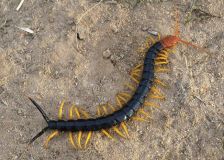Centipedes & Millipedes
 Description: Centipedes are worm-like arthropods with a flattened body and a distinct head that bears a pair of long antennae. Jaws containing venom glands are located on the first body segment behind the head. Centipedes, or “100-legged worms,” have only one pair of legs on each body segment. Depending on the species, centipedes can vary in length from one to 12 or more inches, with the total number of legs varying from 10 to 100 or more. The most common species of centipede found in Oklahoma is two to six inches long. Centipedes can range in color from yellowish-brown, dark brown, to iridescent reddish-green.
Description: Centipedes are worm-like arthropods with a flattened body and a distinct head that bears a pair of long antennae. Jaws containing venom glands are located on the first body segment behind the head. Centipedes, or “100-legged worms,” have only one pair of legs on each body segment. Depending on the species, centipedes can vary in length from one to 12 or more inches, with the total number of legs varying from 10 to 100 or more. The most common species of centipede found in Oklahoma is two to six inches long. Centipedes can range in color from yellowish-brown, dark brown, to iridescent reddish-green. Millipedes Description: Millipedes are worm-like, slender, hard-shelled arthropods with rounded body segments. Millipedes differ from centipedes in that they have one pair of short antennae on the head and two pairs of legs on each body segment. They are commonly called “thousand leggers,” even though they may only have 60 to 400 legs. Millipede species vary in length from one to two or more inches. They also vary in color from reddish-brown to black. When dead or disturbed, millipedes tend to curl themselves into a tight coil. Although harmless, many millipedes have defensive glands that emit a foul-smelling fluid when disturbed or handled.
Description: Millipedes are worm-like, slender, hard-shelled arthropods with rounded body segments. Millipedes differ from centipedes in that they have one pair of short antennae on the head and two pairs of legs on each body segment. They are commonly called “thousand leggers,” even though they may only have 60 to 400 legs. Millipede species vary in length from one to two or more inches. They also vary in color from reddish-brown to black. When dead or disturbed, millipedes tend to curl themselves into a tight coil. Although harmless, many millipedes have defensive glands that emit a foul-smelling fluid when disturbed or handled.
Habitat: Most millipedes feed on damp and decaying vegetation and leaf litter, although some species will attack the roots and lower leaves of living plants. They spend most of their life in the soil. Adult millipedes spend the winter in soil, debris, and leaf litter found under trees.
Life Cycle: Female millipedes begin to lay their eggs in the spring. It has been reported that a female millipede can produce as many as 300 eggs at one time. These eggs are laid in the soil in several small clusters of 20 to 100 eggs. In about three weeks, the eggs hatch into tiny larvae with only three pairs of legs. As millipedes grow, they molt from seven to ten times, adding additional body segments and legs with each molt. Millipedes stop growing when they reach sexual maturity. Adults may live for two to five years. It is thought that we only have one generation of millipedes per year in Oklahoma.
Symptoms: Millipedes occasionally wander from their moist living places into homes, but they usually die because of the dry conditions and lack of food. However, there are some occasions when millipedes invade houses in large numbers. In these cases, we often see millipedes migrating, in an uphill direction, as their food supply dwindles or their living areas become too wet or too dry. In Oklahoma, these migrations often result during drought periods following a build-up of the millipede population during favorable spring conditions.
Millipedes are also attracted to lights, and it is common to have them migrate to lighted swimming pools, patios, driveways, or industrial areas. Even though they may invade houses, they pose no threat. They do not bite, sting, cause structural damage, contaminate foodstuffs, or eat fibers.
House Centipede
 Description: The body is 1 to 1-1/2 inch long, but its 15 pairs of legs make it appear to seem much larger. The body is grayish-yellow with 3 dark stripes extending along the full length of the back. The legs are long in proportion to the body size, and they have alternate light and dark bands running around them.
Description: The body is 1 to 1-1/2 inch long, but its 15 pairs of legs make it appear to seem much larger. The body is grayish-yellow with 3 dark stripes extending along the full length of the back. The legs are long in proportion to the body size, and they have alternate light and dark bands running around them.
Habitat: Though house centipedes are found both indoors and outdoors it is the occasional one on the bathroom or bedroom wall, or the one accidentally trapped in the bathtub, sink, or lavatory that causes the most concern. Centipedes prefer to live in damp portions of basements, closets, bathrooms, unexcavated areas under the house and beneath the bark of firewood stored indoors. House centipedes feed on small insects, insect larvae, and on spiders. Thus they are beneficial, though most homeowners take a different point-of-view and consider them a nuisance.
Bite: Technically, the house centipede could bite, but it is considered harmless to people.